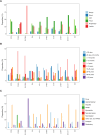Epidemiological and Clinical Insights into Enterovirus Circulation in Europe, 2018-2023: A Multicenter Retrospective Surveillance Study
- PMID: 40184501
- PMCID: PMC12308651
- DOI: 10.1093/infdis/jiaf179
Epidemiological and Clinical Insights into Enterovirus Circulation in Europe, 2018-2023: A Multicenter Retrospective Surveillance Study
Abstract
Background: Enteroviruses (EV) cause yearly outbreaks with severe infections, particularly in young children. This study investigates EV circulation, age, and clinical presentations in Europe from 2018 to 2023.
Methods: Aggregated data were requested from the European Centre for Disease Prevention and Control National Focal Points for Surveillance and European Non-Polio Enterovirus Network. Data included detection month, specimen type, age group, and clinical presentation for the 10 most commonly reported EV types per year.
Results: Twenty-eight institutions (16 countries) reported 563 654 EV tests during the study period with 33 265 (5.9%) EV positive. Forty-two types were identified (n = 11 605 cases) with echovirus 30 (E30), coxsackievirus A6 (CVA6), EV-D68, E9, E11, CVB5, E18, CVB4, EV-A71, and E6 most frequently reported. E30 declined after 2018/2019, while CVA6, CVB5, E9, E11, and EV-D68 were prevalent both before and after the coronavirus disease 2019 (COVID-19) pandemic, and CVB4 and E18 were prevalent after the pandemic. A shift in seasons (summer to fall) and specimen positivity (feces to respiratory) was observed. Neurological signs predominated among EV-A71, CVB4, CVB5, E6, E9, E11, E18, and E30 (30%-72%). CVB4, CVB5, E9, E11, and E18 were frequently reported among neonates (18%-32%). CVA6 was frequently associated with hand, foot and mouth disease, and EV-D68 with respiratory infections. Paralysis was reported among 22 infections, associated with 10 nonpolio types.
Conclusions: This study emphasizes the widespread circulation and severity of EV infections in Europe, as well as the (re)emergence of specific types postpandemic. Our findings highlight the need for continuous EV surveillance to monitor variation in circulation, age, and clinical presentations, including paralysis among nonpolio EV infections.
Keywords: Europe; enterovirus; epidemiology; laboratory detection; surveillance.
© The Author(s) 2025. Published by Oxford University Press on behalf of Infectious Diseases Society of America.
Conflict of interest statement
Potential conflicts of interest. All authors: No reported conflicts of interest. All authors have submitted the ICMJE Form for Disclosure of Potential Conflicts of Interest. Conflicts that the editors consider relevant to the content of the manuscript have been disclosed.
Figures





References
-
- Picornaviridae Study Group . Picornaviridae study group pages. http://www.picornastudygroup.com/. Accessed 12 March 2025.
-
- Harvala H, Broberg E, Benschop K, et al. Recommendations for enterovirus diagnostics and characterisation within and beyond Europe. J Clin Virol 2018; 101:11–7. - PubMed
-
- Chuang YY, Huang YC. Enteroviral infection in neonates. J Microbiol Immunol Infect 2019; 52:851–7. - PubMed

